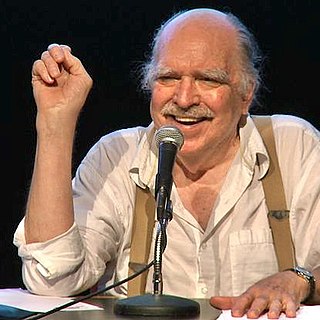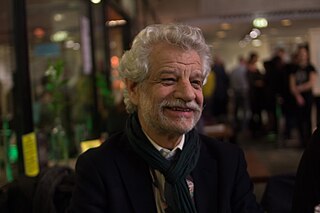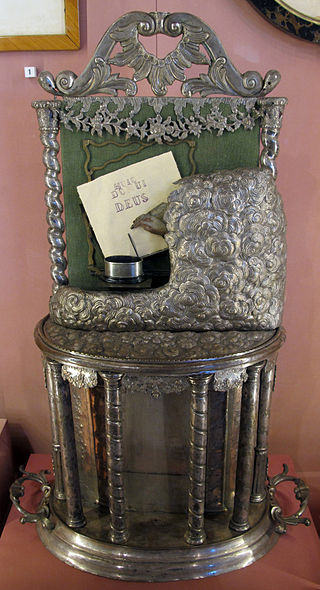Related Research Articles

William Alfred Higinbotham was an American physicist. A member of the team that developed the first nuclear bomb, he later became a leader in the nonproliferation movement. He also has a place in the history of video games for his 1958 creation of Tennis for Two, the first interactive analog computer game and one of the first electronic games to use a graphical display.

Peter Weibel was an Austrian post-conceptual artist, curator, and new media theoretician. He started out in 1964 as a visual poet, then later moved from the page to the screen within the sense of post-structuralist methodology. His work includes virtual reality and other digital art forms. From 1999 he was the director of the ZKM Center for Art and Media Karlsruhe.
The imaginary is the set of values, institutions, laws, and symbols through which people imagine their social whole. It is common to the members of a particular social group and the corresponding society. The concept of the imaginary has attracted attention in anthropology, sociology, psychoanalysis, philosophy, and media studies.

From Caligari to Hitler: A Psychological History of the German Film is a book by film critic and writer Siegfried Kracauer, published in 1947.

Alexander R. Galloway is an author and professor in the Department of Media, Culture, and Communication at New York University. He has a bachelor's degree in Modern Culture and Media from Brown University and earned a Ph.D. in Literature from Duke University in 2001. Galloway is known for his writings on philosophy, media theory, contemporary art, film, and video games.
Kenneth E. Rinaldo is an American neo-conceptual artist and arts educator, known for his interactive robotics, 3D animation, and BioArt installations. His works include Autopoiesis (2000), and Augmented Fish Reality (2004), a fish-driven robot.

Gene Youngblood was an American theorist of media arts and politics, and a respected scholar in the history and theory of alternative cinemas. His best-known book, Expanded Cinema, was the first to consider video as an art form and has been credited with helping to legitimate the fields of computer art and media arts. He is also known for his pioneering work in the media democracy movement, a subject on which he taught, wrote, and lectured, beginning in 1967.

The Polyorama Panoptique was an optical toy popular from the 1820s through to the 1850s. It was invented by Pierre Seguin as development of the earlier "protean view". The device was based on Daguerre's Diorama, of which it was a small-scale and simplified version intended for domestic use. It consisted of a portable box-camera designed to take printed and painted cards.
Jussi Ville Tuomas Parikka is a Finnish new media theorist and Professor in Digital Aesthetics and Culture at Aarhus University, Denmark. He is also (visiting) Professor in Technological Culture & Aesthetics at Winchester School of Art as well as Visiting Professor at FAMU at the Academy of Performing Arts in Prague. In Finland, he is Docent of digital culture theory at the University of Turku. Until May 2011 Parikka was the Director of the Cultures of the Digital Economy (CoDE) research institute at Anglia Ruskin University and the founding Co-Director of the Anglia Research Centre for Digital Culture. With Ryan Bishop, he also founded the Archaeologies of Media and Technology research unit.
Jeffrey Shaw is a visual artist known for being a leading figure in new media art. In a prolific career of widely exhibited and critically acclaimed work, he has pioneered the creative use of digital media technologies in the fields of expanded cinema, interactive art, virtual, augmented and mixed reality, immersive visualization environments, navigable cinematic systems and interactive narrative. Shaw was co-designer of Algie the inflatable pig, which was photographed above Battersea Power Station for the 1977 Pink Floyd album, Animals.

Thomas Elsaesser was a German film historian and professor of Film and Television Studies at the University of Amsterdam. He was also the writer and director of The Sun Island, a documentary essay film about his grandfather, the architect Martin Elsaesser. He was married to scholar Silvia Vega-Llona.
Siegfried Zielinski is a German media theorist. He held the chair for Media Theory: Archaeology and Variantology of the Media at Berlin University of the Arts, he is Michel Foucault Professor for Techno-Culture and Media Archaeology at the European Graduate School in Saas Fee, and he is director of the International Vilém-Flusser-Archive at the Berlin University of the Arts. In 2016 until March 2018, he succeeded Peter Sloterdijk as head of the Karlsruhe University of Arts and Design.
Henry Langdon Childe (1781–1874) was an English showman, known as a developer of the magic lantern and dissolving views, a precursor of the dissolve in cinematic technique. While the priority question on the technical innovations Childe used is still debated, he established the use of double and triple lanterns for special theatrical effects, to the extent that the equipment involved became generally available through suppliers to other professionals. By the 1840s the "dissolving view", rooted in Gothic horror, had become a staple of illustrated talks with restrained animations.
Media art history is an interdisciplinary field of research that explores the current developments as well as the history and genealogy of new media art, digital art, and electronic art. On the one hand, media art histories addresses the contemporary interplay of art, technology, and science. On the other, it aims to reveal the historical relationships and aspects of the ‘afterlife’ in new media art by means of a historical comparative approach. This strand of research encompasses questions of the history of media and perception, of so-called archetypes, as well as those of iconography and the history of ideas. Moreover, one of the main agendas of media art histories is to point out the role of digital technologies for contemporary, post-industrial societies and to counteract the marginalization of according art practices and art objects: ″Digital technology has fundamentally changed the way art is made. Over the last forty years, media art has become a significant part of our networked information society. Although there are well-attended international festivals, collaborative research projects, exhibitions and database documentation resources, media art research is still marginal in universities, museums and archives. It remains largely under-resourced in our core cultural institutions.″
Erkki Huhtamo is a media archaeologist, exhibition curator, and professor at the University of California, Los Angeles in the Departments of Design Media Arts and Film, Television, and Digital Media.
Garnet Hertz is a Canadian artist, designer and academic. Hertz is Canada Research Chair in Design and Media Art and is known for his electronic artworks and for his research in the areas of critical making and DIY culture.

The writing hand is a mechanical automaton created by Friedrich von Knauss in 1764. A clockwork mechanism moves a hand which dips a pen into an inkstand and writes the phrase "Huic Domui Deus / Nec metas rerum / Nec tempora ponat" on a small card. On the silver-coating of the mechanism are the words "Pro patria".
Giuliana Bruno is a scholar of visual art and media. She is currently the Emmet Blakeney Gleason Professor of Visual and Environmental Studies at Harvard University. She is internationally known as the author of numerous influential books and articles on art, architecture, film, and visual culture.

Tony D. Sampson is a British academic author who writes about philosophies of affect, digital media cultures and labour, marketing power, design/brand thinking, social and immersive user experiences and neurocultures. He is best known for his widely cited and debated academic publications on virality, network contagion and neuroculture. This work is influenced by the 19th century French sociologist, Gabriel Tarde and concerns contemporary analyses of viral phenomena and affective and emotional contagion on the Internet. In 2017 Sampson published The Assemblage Brain, a book about the culture of the affective brain explored through digital media, the neurosciences, business (marketing), cybernetics and political power. His most recent publication, A Sleepwalker's Guide to Social Media (2020), explores the power dynamic of a post-Cambridge Analytica social media environment wherein the marketing logic of virality/growth helps to inflame contagions of race hate, posing a threat to democracy.
Lori Emerson is an associate professor at the University of Colorado at Boulder and founder of the Media Archaeology Lab, a museum dedicated to obsolete technologies spanning from the late nineteenth century to the twenty-first century. She is known for her work in media archaeology, digital preservation, and digital archives.
References
- 1 2 3 Parikka, Jussi. "'With each project I find myself reimagining what cinema might be': An Interview with Zoe Beloff". Electronic Book Review, 24 October 2011.
- 1 2 3 "CTheory Interview: Archaeologies of Media Art". Conversation between Jussi Parikka and Garnet Hertz, ctheory.net, 1 April 2010.
- 1 2 Natale, Simone. "Understanding Media Archaeology". Canadian Journal of Communication, vol. 37 (2012), pp 523–527.